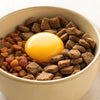Is Raw Dog Food Good for Your Dog? Unpacking the Benefits and Risks
- Houndsy
Table of Contents
- Introduction
- Understanding Raw Dog Food Diets
- Benefits of Feeding Raw Dog Food
- Potential Risks of Raw Dog Food
- Making the Decision: Is Raw Dog Food Right for Your Pet?
- Conclusion
- FAQs
Introduction
Have you ever walked down the pet food aisle and felt overwhelmed by the myriad of choices? With the rise of raw diets, many pet owners are left wondering, “Is raw dog food good for your dog?” Recent statistics indicate that sales of raw pet food have surged by at least 15% annually, with anywhere from 15% to 25% of dog owners incorporating raw meat into their pets' diets. As more dog parents pivot toward a more natural approach to nutrition, it is crucial to assess the implications—both positive and negative—of feeding our canine companions raw food.
In this blog post, we will explore the essential elements of raw dog food diets, uncover the potential benefits and drawbacks, and address common questions that arise in relation to this feeding approach. By the end, you'll have a comprehensive understanding that will help you make an informed decision for your furry friend. We invite you to reflect on your own dog's nutrition and how it aligns with your pet's health and lifestyle.
Understanding Raw Dog Food Diets
What is Raw Dog Food?
At its core, a raw dog food diet consists of unprocessed, whole food ingredients that cater to a dog’s ancestral eating habits. The diet typically includes:
- Muscle meats (often with bones)
- Organ meats (like liver and kidneys)
- Raw eggs
- Fruits and vegetables (such as carrots, apples, and leafy greens)
- Dairy items like yogurt or cheese (in moderation)
Many pet owners are motivated to switch to raw by the belief that it mirrors the diet of wild canines—untouched by industrial processing. However, understanding the specifics of a raw diet is essential for ensuring it is both safe and nutritionally adequate.
Origins of the Raw Food Movement
The concept of feeding pets raw diets gained traction in the early 1990s when Australian veterinarian Ian Billinghurst introduced the BARF diet (Bones and Raw Food). His premise was that grain-laden commercial dog food was detrimental to canine health. While raw feeding appeals to many, it raises pertinent questions regarding its nutritional completeness and food safety.
Benefits of Feeding Raw Dog Food
Health Improvements
Many advocates of raw dog food diets tout several health benefits, which often include:
-
Enhanced Energy Levels: Owners frequently report that their dogs exhibit increased vitality and active behavior after making the switch to raw feeding.
-
Improved Coat Condition: Raw feeding proponents note that their dogs have shinier coats, attributed to higher fat content and the nutrients found in raw meats. A diet rich in essential fatty acids can support skin health and reduce shedding.
-
Cleaner Teeth: The act of chewing raw meaty bones can contribute to dental hygiene by minimizing plaque buildup and supporting oral health.
-
Balanced Weight: By controlling portions and incorporating high-quality protein sources, pet owners have reported more manageable and healthy weight in their pets.
-
Fewer Allergies: Some pet owners have found that raw diets can alleviate food allergies or intolerances, particularly with limited-ingredient raw options.
-
Smaller, Less Odorous Stools: Many dogs on raw diets produce firmer stools that are less odorous, likely due to better nutrient absorption.
Nutritional Benefits
Raw diets are often rich in protein and contain bioactive compounds that may enhance immune function. Some raw food formulations provide antioxidants such as vitamins C and E, which can have a protective effect on health.
Potential Risks of Raw Dog Food
Bacterial Contamination
One of the primary concerns surrounding raw diets is the risk of bacterial contamination. Studies have shown that commercially available raw dog foods can harbor pathogens, including Salmonella and Listeria, which pose risks not only to dogs but to humans as well. The Centers for Disease Control and Prevention (CDC) and the American Veterinary Medical Association (AVMA) strongly caution against unregulated raw feeding due to potential hazards.
Nutritional Imbalance
Feeding a raw diet carries the risk of nutrient deficiencies or excesses. Dogs have specific dietary requirements for vitamins and minerals, and without proper formulation, their nutritional needs may not be met, leading to health issues over time. For instance, raw food diets can sometimes contain:
- Insufficient calcium and phosphorus, causing dental and bone problems, particularly in growing puppies.
- Excessive vitamin A, leading to toxicity if liver is over-consumed.
Risk Factors with Bones
While raw bones can provide dental health benefits, they can also pose physical risks, such as choking hazards or internal injuries if pieces splinter. It’s essential to choose the right type of bones and supervise consumption to mitigate these risks.
Feeding Challenges
Transitioning to a raw diet requires careful consideration and planning. It can be a time-consuming process to research and prepare balanced meals. Ensuring safe food handling practices is paramount, as any negligence can lead to health issues for pets and humans alike.
Making the Decision: Is Raw Dog Food Right for Your Pet?
Consulting Your Veterinarian
Before embarking on a raw food journey with our dogs, it is crucial to engage our veterinarians. They can provide personalized recommendations based on our pet’s unique health needs, breed, age, and lifestyle. For example, puppies, elderly dogs, and those with pre-existing health conditions might warrant a different nutritional approach altogether.
Balancing Raw Nutrition
If you’re considering a raw diet, look for commercial options that comply with the Association of American Feed Control Officials (AAFCO) nutrition profiles. Another option is to work with a veterinary nutritionist to develop a balanced, homemade raw diet. A well-researched feeding plan can help ensure that all essential nutrients are included, reducing the risk of deficiencies.
Conclusion
The conversation surrounding the question of “Is raw dog food good for your dog?” continues to evolve. There are compelling arguments on both sides, and making an informed decision requires careful consideration of your dog's specific needs, lifestyle, and health conditions.
As devoted dog owners, we strive to provide our pets with the best possible nutrition while considering their well-being and safety. If you’re looking for a product that simplifies your dog-feeding experience, consider our Houndsy Kibble Dispenser. Designed to meet ergonomic needs while maintaining beautiful aesthetics, it offers the convenience of precise portion control without the mess. Explore our Kibble Dispenser here.
FAQs
What should I look for in a raw dog food diet?
When selecting raw dog food, we should ensure that it meets nutritional adequacy statements from AAFCO, includes a varied protein source, and is free from harmful pathogens.
Can all dogs eat raw food?
Not all dogs are suitable candidates for raw diets. Puppies, elderly dogs, and those with certain health conditions (like kidney or liver disease) may require alternative feeding options.
Are there any health risks associated with raw dog food?
Yes, raw dog food can pose various health risks, including bacterial contamination and potential nutritional imbalances if not properly formulated or handled.
Should I talk to my vet before transitioning to raw?
Absolutely! Consulting with your veterinarian is crucial to ensure that your dog’s specific dietary needs are considered and met correctly.
By understanding the pros and cons of raw feeding, we can make the best decisions for our furry friends and create a feeding routine that supports their health and happiness.












